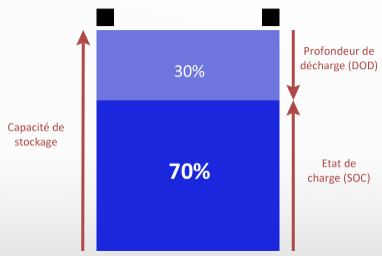Reminders on battery sizing*

Power and energy
In electricity, power and energy are two closely related concepts:
P: instantaneous power (in watts, W)
U or V: voltage (in volts, V)
I: current (in amperes, A)
E: energy (in watt-hours, Wh)
Ah: battery electrical capacity
Usable capacity of a battery
A battery is never sized at 100% of its nominal capacity, as this would significantly reduce its lifespan.
One must consider the depth of discharge tolerated (DoD), which is the portion of capacity that can be actually used without damaging the cells.
For an LFP (LiFePO₄) battery: generally, 80 to 90% of the nominal capacity is considered usable.
An additional margin (~20%) is then applied to compensate for real usage conditions (temperature, slope, momentary overloads, etc.).
Calculation example
Requirement:
A tool of 1.2 kW operates for 2 hours at 48 V.
Calculation of required usable energy:
Adding the safety margin (20%):
Choosing a suitable battery pack:
A LFP 51.2 V – 75 Ah module is perfectly suitable:
This pack meets the requirement by incorporating the safety margin.
Best practices
Always plan for a slightly higher capacity than the estimated need to account for temperature variations, current spikes, or natural battery degradation.
Ensure that the pack's nominal discharge current is compatible with the required power.
Adjust the number of cells in series/parallel to achieve the desired voltage and capacity.
*: The technical information presented in this article is provided for guidance only. It does not replace the official manuals from manufacturers. Before any installation, handling, or use, please consult the product documentation and adhere to safety instructions. Torque.works cannot be held responsible for inappropriate use or incorrect interpretation of the information provided.